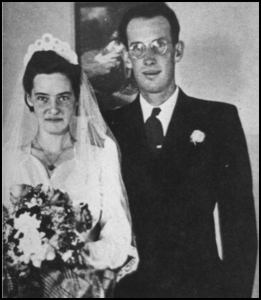
Elsie and Archie Mitchell
On the morning of May 5, 1945, Elsie Mitchell, the wife of Pastor Archie Mitchell, took her Sunday school class for a picnic near Bly, Oregon. The picnickers consisted of Elsie, her husband Archie, and five children, Edward Engen, age 13, Jay Gifford, age 13, Joan Patzke, age 13, Dick Patzke, age 14, Sherman Shoemaker, age 11. As Pastor Mitchell was parking the car, Elsie and the children discovered a large balloon with a peculiar device attached to it, lying in a field. The party neared the device. There was no way for Elsie to know that the balloon and device was a Japanese weapon of war. It exploded killing all six instantly. By all accounts, the six victims of the Bly explosion were the only casualties inflicted on American soil by the Japanese.

WWII Balloon
From November, 1944 to April, 1945 the Japanese Army released over 9000 hydrogen filled balloons into the jet stream. The plan was headed up by Major General Sueyoshi Kusaba, commander of the Imperial Army’s research laboratory. A research team had discovered the jet stream by accident and realized that Japan’s winter winds flowed across the Pacific Ocean to the United States. The team first outfitted a rubber coated silk, hydrogen filled balloon but soon discovered that the silk would leak. They choose instead a dense paper derived from mulberry trees. The device by which the explosive ordinance would be carried was designed to not only explode upon landing but keep itself inside of the jet stream using ballast bags of sand and a valve to release hydrogen. With the sandbags, explosives and device, the total payload on the balloon, upon liftoff, was nearly one thousand pounds.
In the six month time period of the attempted attack on America, approximately 9300 balloons were released by the Japanese Army. It is widely believed by researchers that only 300 ever made it to the U.S., Canada or Mexico. In the U.S., sightings of balloons or downed balloons were reported in seventeen states. When the strange balloons began to show up in America, pilots were ordered to shoot them down. A few, however, did not get shot down. Several of these exploded in the forest of California, Oregon and Washington causing wildfires. Several of the balloon missiles landed and did not detonate. Over time these were rounded up by military authorities and destroyed, except for a few that are presently located in museums.

Elsie Mitchell Tombstone
In the U.S., the military and government did everything within their power to keep media outlets from reporting on the “Japanese Fire Bombs”, although this would and could put Americans at risk, as in the case of Mrs. Elsie Mitchell and her Sunday school class. In Japan it was reported that the bombs were hitting key targets and cities and that thousands were dead or injured and that the American moral was very low. This was clearly the propaganda machine at work against its own people for it is known that only six people lost their lives. Mrs. Elsie Mitchell was honored with a monument.
